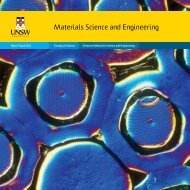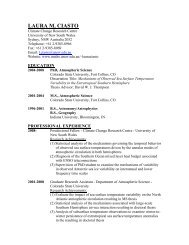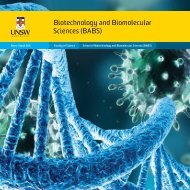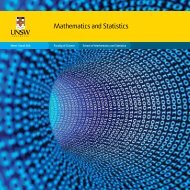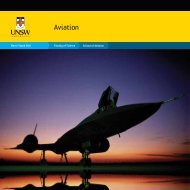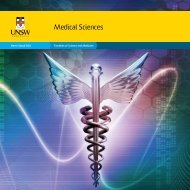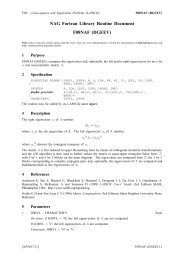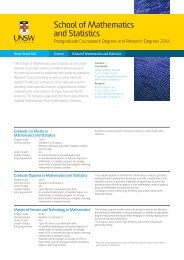2011 Postgraduate Research Competition - UNSW Science - The ...
2011 Postgraduate Research Competition - UNSW Science - The ...
2011 Postgraduate Research Competition - UNSW Science - The ...
You also want an ePaper? Increase the reach of your titles
YUMPU automatically turns print PDFs into web optimized ePapers that Google loves.
Page |5<br />
Weak jaws linked to extinction in Tassie tiger<br />
Marie Attard, Steve Wroe and Tracey Rogers<br />
School of Biological, Earth & Environmental <strong>Science</strong>s<br />
Abstract<br />
With rapidly increasing rates of contemporary extinctions, predicting extinction vulnerability<br />
has become a key challenge in ecology. Understanding risk factors associated with<br />
extinction, such as diet, may assist future conservation efforts. Australia’s iconic species, the<br />
thylacine, or commonly known as the Tassie tiger was a large carnivore and the only<br />
marsupial to become extinct in Tasmania following European settlement. <strong>The</strong> factors<br />
involved in its extinction have been argued, yet the underlying cause of their decline remains<br />
incomplete. Using advanced computer modelling techniques, we simulated various<br />
predatory behaviours to see patterns of stress in the skull. Simulations of thylacine skull<br />
performance were compared to living marsupial carnivores capable of catching large<br />
animals. Our findings suggest that the thylacine’s jaws were too weak to capture and kill<br />
large prey. Rather, their exceptionally long snout was better suited to snapping up smaller,<br />
more agile prey. Specialising in small prey may have short-term success but is a long-term risk;<br />
as they are among the first to become extinct when the ecosystem becomes destabilised.<br />
With this inherent vulnerability, thylacines may have simply been unable to cope with<br />
environmental disturbances such as intensive hunting and habitat degradation following<br />
European arrival.<br />
Impact of Micro-fabricated Surfaces and<br />
Protozoan Grazing on Marine Microbial Biofilms<br />
Abstract<br />
Min Hui Low, Staffan Kjelleberg and Diane McDougald<br />
School of Biotechnology & Biomolecular <strong>Science</strong>s<br />
<strong>The</strong> impact of protozoan grazing on microbial biofilms developed on micro-fabricated polydimethyl<br />
siloxane (PDMS) surfaces was assessed after 20 days of exposure in the marine<br />
environment. Four different PDMS surfaces were used; 1, 2, 4 and 10 µm parallel grooves with<br />
equal widths and heights for the 4 and 10 µm fabrications, and equal widths but 0.5 µm in<br />
height for the 1 and 2 µm surfaces. At a depth of 2 meters in waters off the Sydney coast,<br />
biofilms were pre-established on the different micro-fabricated surfaces within environmental<br />
diffusion chambers for 15 days in the absence of large protozoans, then challenged with the<br />
surface feeding flagellate, Rhynchomonas nasuta for 5 days before sampling. 3D-images of<br />
biofilms were scanned using confocal laser scanning microscope (CLSM) and biomass<br />
quantified by IMARISTM software. Extracted DNA from the microbial community was<br />
analysed by 16S- terminal-restriction length polymorphism (T-RFLP) to investigate community<br />
composition differences on surfaces with and without of R. nasuta. Based on MDS and<br />
biovolume difference, R. nasuta grazing played a more crucial role in changing community<br />
compositions compared to micro-fabricated surfaces but biovolume differences on microfabricated<br />
surfaces is little between the presence and absence of R nasuta.<br />
|climate, environment & sustainability



